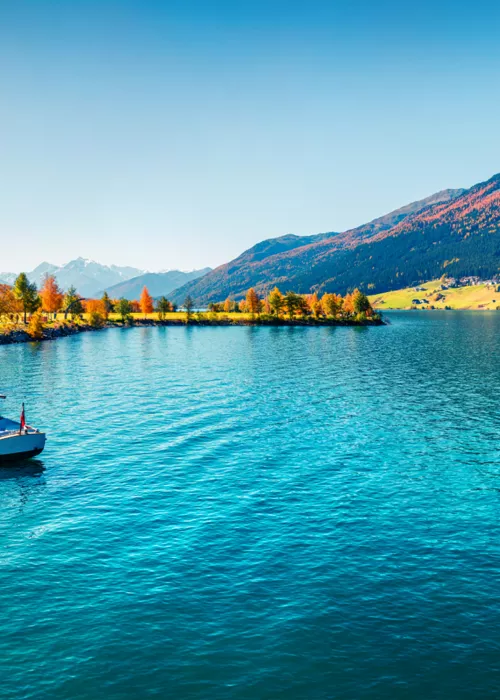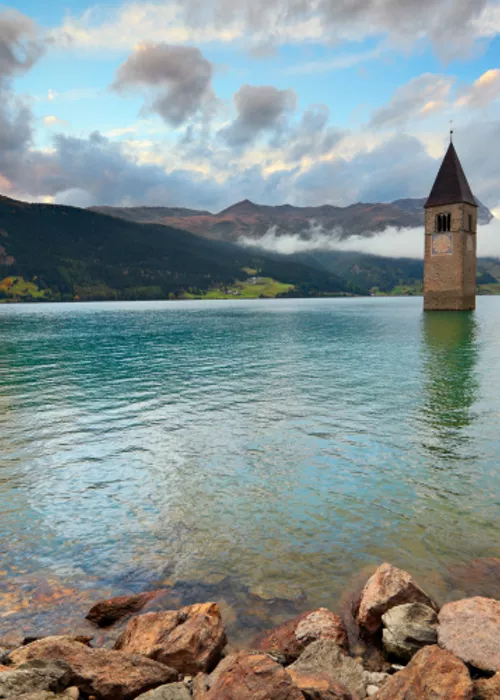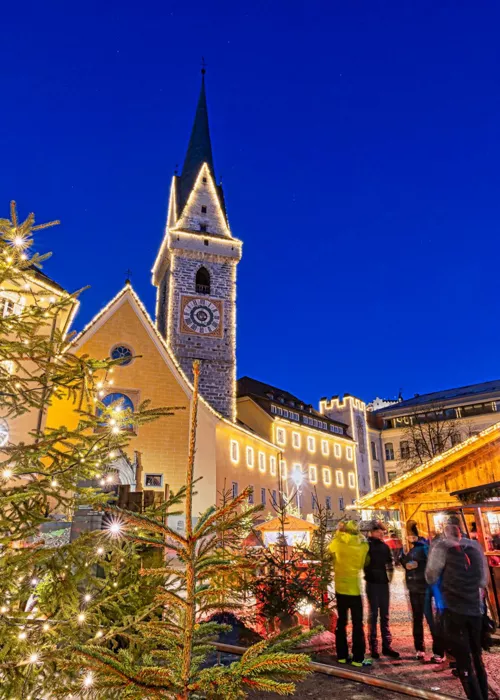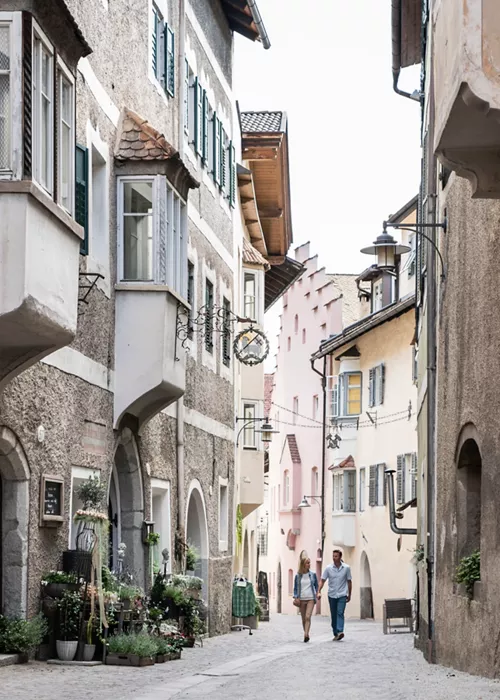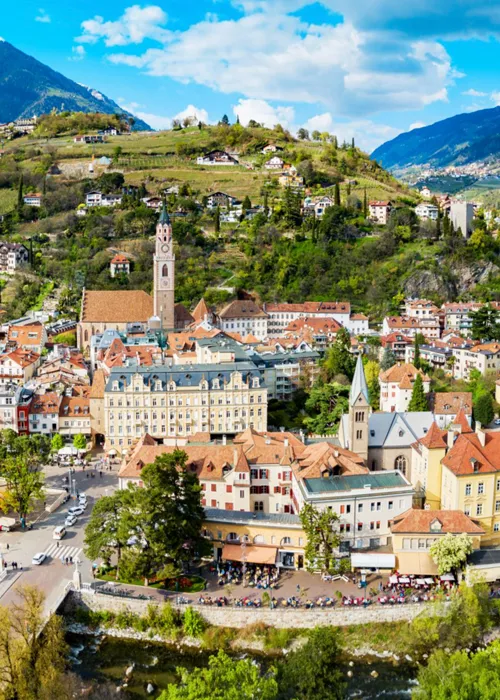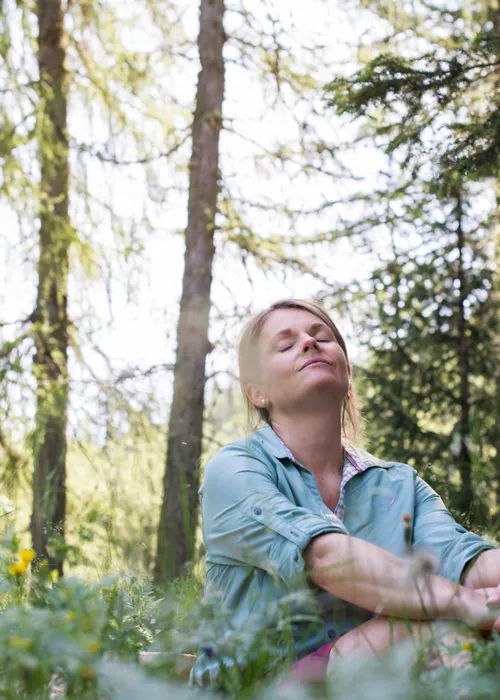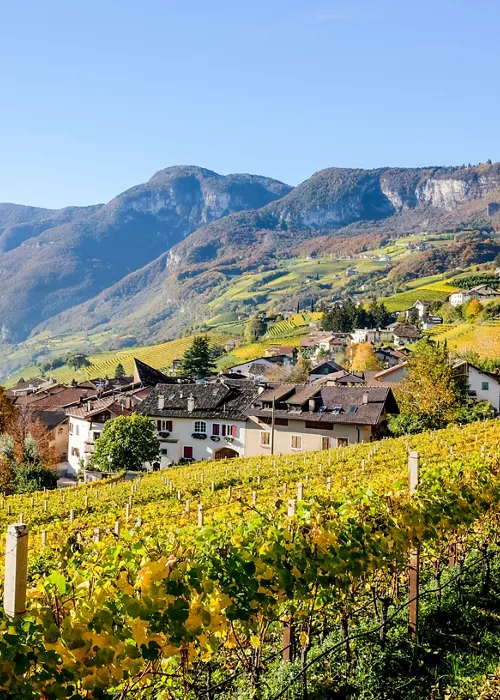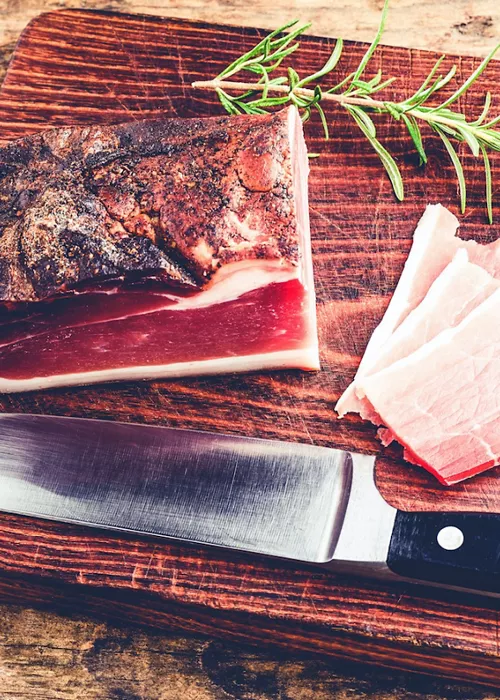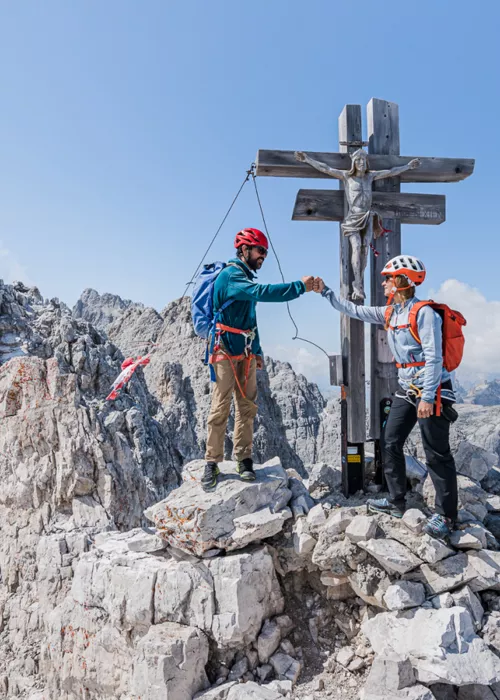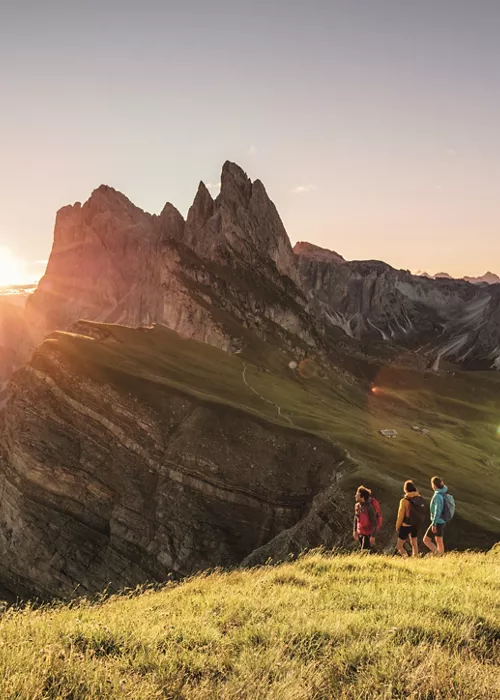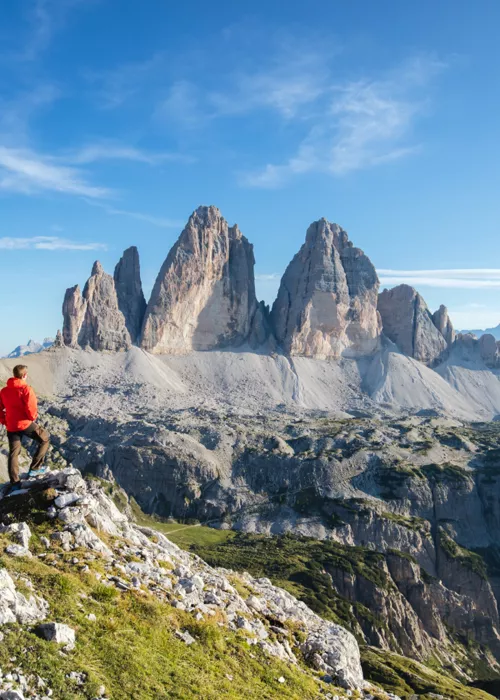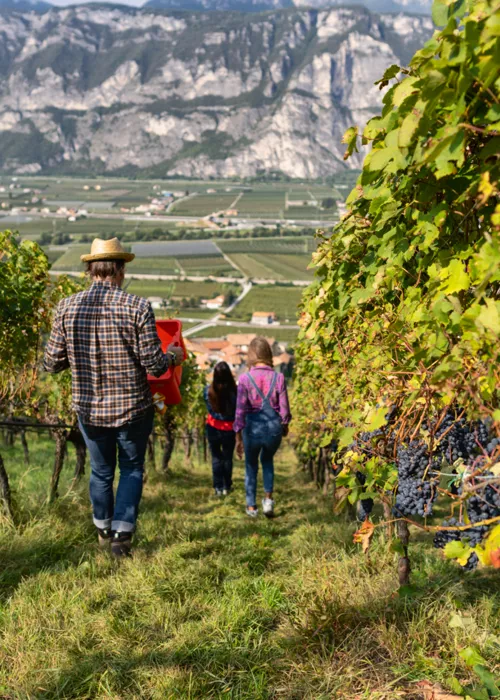3 Charming Villages in the Heart of Alto Adige
10 minutes

Visiting Chiusa, Vipiteno and Barbiano provides a wonderful introduction to Alto Adige in Northern Italy. These charming villages provide a full travel experience that includes mountain scenery, fascinating history and local cuisine.
Chiusa (Klausen)

Popular with hikers, clerics and artists for centuries, Chiusa stole our hearts after just one day. This medieval village has historic buildings, a gothic church, a world-class winery and restaurants that serve local, seasonal food. Plus, the Adige River rambles through the village, a situation which makes picturesque Chiusa even easier to love.
Top 5 Things Not to Miss in Chiusa
- Trostburg Castle
- Sabiona Monastery
- Chestnut Trail
- Cantina Valle Isarco
- Food to Taste: Seasonal South Tryol Food Specialties
Perched on a hill overlooking the village, the Sabiona Monastery is never far from view in Chiusa. When we woke up in the morning, the monastery was the first site we saw. It lorded over the town as we explored Chiusa during the day and it made a lit appearance after we finished dinner and strolled home from one of Chiusa’s excellent gasthauses at night.
This ‘Acropolis of Tyrol’ isn’t just for show. Adventurous hikers can climb up to the monastery while the rest of us can simply enjoy the view while sipping coffee or a glass of wine. Not your average monastery, this one has a long, spiritual history that rivals its scenic spot.
The monastery is just one reason why Chiusa is officially ranked as one of the most beautiful villages in Italy (Borghi più Belli d'Italia). This designation shows that we’re not the only ones who have discovered the tiny village’s charms. But, to be fair, Chiusa’s charms exist at every twist and turn with its medieval buildings and streams that run through the town. Then there’s the Trostburg Castle.
Dating back to the 13th century, the Trostburg Castle has a grand Renaissance hall and one of the region’s largest wine presses. It’s definitely worth a visit as is the Chestnut Trail, a scenic walking trail with rolling meadows and chestnut groves. Walking is a mandatory activity considering Chiusa’s hearty local food. It’s practically impossible to visit Chiusa without indulging in pastries at one or more of the town’s local bakeries.

During our visit, we wandered through the village, sampling seasonal treats and sipping both coffee and wine along the way. When we stepped into the ancient Sant'Andrea Church, founded in 1308, we felt like we were traveling back to a time when Chiusa was a customs town. (The name Chiusa refers to the town's location as a lock on the Adige River.) Other times, we were happy to soak in the sun while relaxing in the village’s large municipal park. We even discovered a local restaurant with our last name. However, our favorite memories of Chiusa happened outside its historic center, specifically at Gasthaus Huber and Cantina Valle Isarco.
Gasthauses located a short drive from the center of Chiusa are special spots thanks to their Dolomite alpine views and hearty food menus. This is where we ate our first, but not last, bowl of Canederli di Speck in Brodo. We seriously get hungry remembering that comforting speck dumpling which floated in a savory beef broth.
This meal also provided an introduction to the wonderful wines of Alto Adige, an education that we continued at Chiusa’s Cantina Valle Isarco. We couldn’t resist buying two bottles at the winery after enjoying a comprehensive wine tasting. We also couldn’t help noticing the rapid succession of South Tyroleans, who take their wine seriously, buying wine by the caseload. Locals obviously know where the good stuff comes from.
During our short stay in Chiusa, we ate a selection of local specialties as well as pizza. Our favorite meal was at a restaurant located next to a bucolic stream that flows through the center of town. While we sat at a table during this meal, some lucky diners literally ate food like mezzaluna ravioli while seated inside a ginormous wine barrel.
We also enjoyed eating pizza at riverside Chiusa restaurants. Our favorite pies were topped with speck, Tyrol’s famous smoked ham, but that topping is optional. We say add the speck!
Chiusa Useful Information
Best Time to Visit:
Although Chiusa is a four-season destination, autumn may be the very best time of the year to visit for those who enjoy wine harvests and roasted chestnuts. Plus, the village’s autumnal Törggelen festival is legendary.
How to Get There:
Chiusa is located 32 kilometers (approximately 20 miles) from Bolzano. Beyond driving, sustainable transportation options include taking a train or bus. However, having a car is the best option for those who wish to explore beyond the village center.
Vipiteno (Sterzing)

Vipiteno is one of the most special places to visit in the region. Not only is this medieval village designated as one of the most beautiful villages in Italy (Borghi più Belli d'Italia), but it’s also one of just two Alto Adige villages certified with the Orange Flag (Bandiere Arancioni) of the Italian Touring Club. Marking Vipiteno as having a tourist-friendly environment, this flag is a badge of honor that’s well respected by Italian tourists.
Top 5 Things Not to Miss in Vipiteno
- Torre delle Dodici (Tower of the Twelve)
- Church of the Holy Ghost
- Multscher Art Museum
- Local Shops and Eateries
- Food to Taste: Pizza and Traditional Tyrolean Food
Dating back to the 15th century, the impressive Tower of Twelves (also known as the Torre delle Dodici) stands on the Reichstrasse, Vipiteno’s main shopping street. The clock, which separates the old and new towns, has seen the world change, ticking its way past the renaissance and through two world wars.
The tower is a slender structure that’s decorated with both a clock and sundial. Rebuilt in 1867 after it was damaged by a fire, this iconic timepiece is a show-stopper that’s impossible to miss or forget.
History continues to touch this historic town commonly known in German as Sterzing. Being at the foot of the Brenner pass, the charming village has stories to tell. In 2016, a World War Two bomb had to be diffused after the town was evacuated.
But this mountain village is much more than a sum of its history which goes back to the 12th century and continued later when the original settlement expanded to include a contrasting area called ‘New Town.’ Vipiteno doesn’t hide its beauty or friendliness under a bushel, and its tower is just one thing to see here.
This is a village that’s easy to explore on foot as we did during our autumn visit. We entered the city, strolling past the town’s blend of modern and traditional cafes, butcheries, clothing stores and churches. We checked out gourmet food shops filled with piles of speck, counters overflowing with Alpine cheeses and shelves stocked to the brim with local wines. We even shopped for alpine jackets at one of the town's trendy ski apparel stores.
We also wandered into churches and strolled past well-appointed mansions. Finally, we dined at a local restaurant for lunch. Once seated, we ordered a speck-topped pizza and spinach-filled mezzaluna ravioli (called Schlutzkrapfen in German). Glasses of local beer and wine completed our mid-day meal.

Full from lunch, we resumed our tour of the village’s historic center at two Vipiteno’s churches. First up was the Church of the Holy Ghost. This ancient 14th century structure is decorated with colorful frescoes painted by local artist Hans von Bruneck. Next, we explored Vipiteno’s parish church which contains five 15th century statues created by the German artist Hans Multscher. Travelers who are inspired by Multscher’s statues can see more of his work at the Multscher Museum located next door.
All that touring and eating made us thirsty. Luckily, Vipiteno is located a short drive from the Novacella Abbey. Possibly older than Vipiteno, this historic abbey was founded in the 12th century and operates one of the oldest wineries in the world. The abbey’s terraced vines sit on a high ridge that can only be accessed through an ancient gated door. Tasting the wine completed our Vipiteno experience. We recommend booking a tour in advance if you want it to complete your experience too.
Vipiteno Useful Information
Best Time to Visit:
Vipiteno welcomes visitors all year long. Summer is especially fun since the village hosts Yogurt Days, an annual event that celebrates the village’s dairy producers and products. Winter is also fun for those who like to ski and want to enjoy Vipiteno’s festive Christmas market.
How to Get There:
Vipiteno is located 69 kilometers (approximately 43 miles) from Bolzano. Beyond driving, sustainable transportation options include taking a train or bus. However, having a car is the best option for those who want to explore beyond the village’s center.
Barbiano (Barbian)

If you blink you might miss Barbiano. This hillside Alto Adige village is tiny but it’s well worth a visit. In some ways, Barbiano’s compact size adds to the village’s charms. Plus, its views are simply breathtaking.
Top 5 Things Not to Miss in Barbiano
- Crooked Church Tower
- Stunning Views and Sweeping Vistas
- Waterfall Hike and Hanging Bridge
- Excursion to the Majestic Corno Renon
- Food to Taste: Weinerschnitzel at Local Gasthauses
Barbiano is a hillside town with magnificent views. We enjoyed these views so much during our morning visit that we returned after an afternoon adventure at Corno del Renon to watch the sun set over the village’s unique church steeple. Despite a curvy ride on mountain roads as dusk slowly arrived, the drive was worth the effort for the spectacular views we experienced.
Barbiano is a hillside town with magnificent views. We enjoyed these views so much during our morning visit that we returned after an afternoon adventure at Corno del Renon to watch the sun set over the village’s unique church steeple. Despite a curvy ride on mountain roads as dusk slowly arrived, the drive was worth the effort for the spectacular views we experienced.
Barbiano is more than its views. For starters, the tiny village has a crooked church tower. At first, we thought that we should adjust our camera. But, no, the 13th century church’s steeple is indeed crooked due to its perilous location on a hill. Although the village has taken efforts to stabilize its crooked church tower, the crooked status adds to its charm.
We started our Barbiano outing by visiting the church and enjoying the kind of hearty local food that’s popular in Alto-Adige. We ate vivid green Canederli di Spinaci (spinach dumplings) and Schnitzel as big as our heads at a local gasthaus. Eating dishes like these provided us with plenty of fuel for the range of activities that surround this village.
Despite its size, Barbiano is a great launching point for afternoon adventures. Many travelers opt to take a 30-minute hike to the Barbiano Waterfalls, a stunning site where water from the Rio Gander cascades in a series of picturesque waterfalls. Adventurous hikers can ascend further to see the site’s upper waterfall.
Another option is to take a 120-meter walk on a hanging bridge that connects Barbiano to Saubach. Constructed in 2021, the panoramic bridge offers epic views to all who traverse it. If heights don’t frighten you, it’s an activity worth considering.

Then there’s Corno del Renon where gondolas whisk visitors to one of Alto Adige’s most epic views. While taking the gondola is a scenic activity on its own, Corno del Renon’s best views require a short hike on a panoramic loop trail. Surrounded by pine trees, this trail offers amazing mountain views along a family-friendly path. There’s a pinnacle at the top that provides a 360 degree view of the Dolomites where it’s possible to look all the way to Austria and beyond.
We stood in awe as we absorbed the pinnacle’s views from every angle including a distant look at the distant Alpe di Siusi. It’s the kind of view that must be seen to be believed. Of course, we took photos from the overlook plus a selfie or two or three.
Corno del Renon serves a different purpose during the winter when people ascend the mountain in gondolas and descend it on skis. However, there’s something special about visiting in the warmer seasons when the region’s fauna and flora are in full bloom.
Barbiano Useful Information
Best Time to Visit:
Spring is the best time to visit for those who want to view the Barbiano Waterfalls in their full glory. However, skiers will want to visit during the colder months when the nearby mountains become a winter wonderland.
How to Get There:
Barbiano is located 28 kilometers (approximately 17 miles) from Bolzano. Beyond driving, transportation options include taking a train or bus. However, having a car is the best option for those who want to explore beyond the village center.
Article written about the experience of Daryl & Mindi Hirsch, 2foodtrippers.
Author: Daryl & Mindi Hirsch, 2foodtrippers


